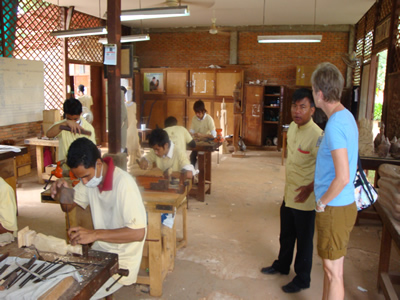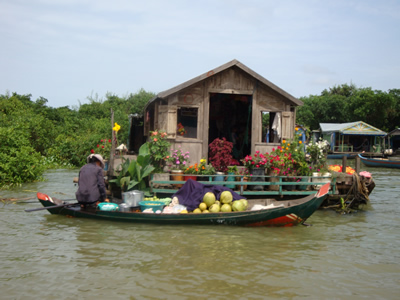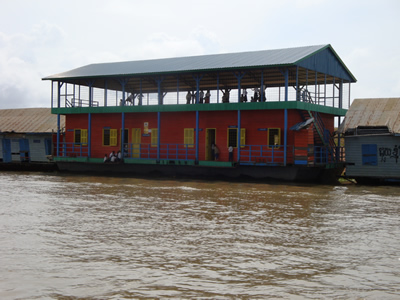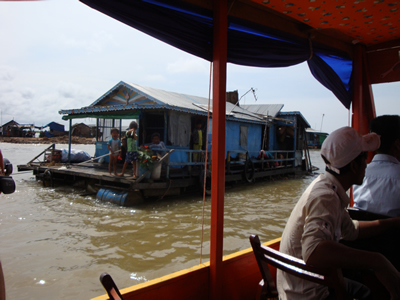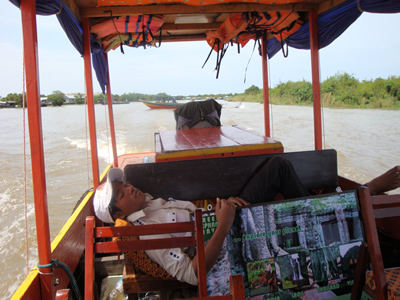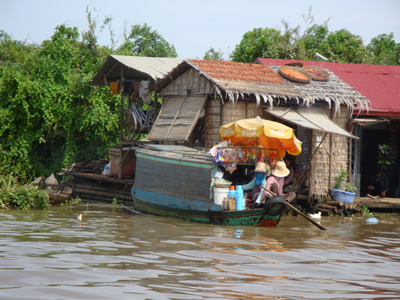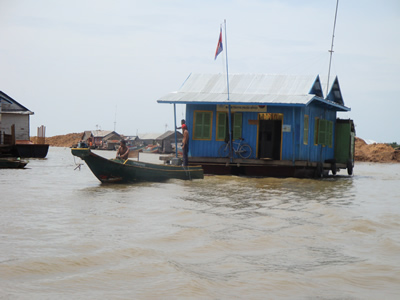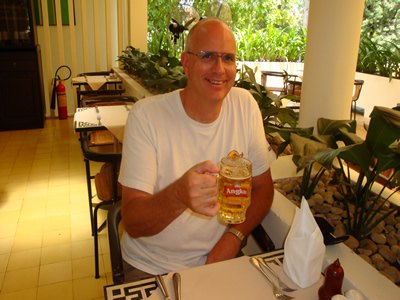Khmer Rouge
In the last post I covered the ancient history of Cambodia and the Khmer Empire. But on our trip I also learned the modern history of Cambodia and the Khmer Rouge. It was fascinating but totally horrifying. Since I was draft age during the 70's I followed events in Vietnam closely. And with my interest in military history I have read quite a bit since then on the history of the Vietnam War. But I didn't know much about Cambodia. It was officially neutral during the war but part of the Ho Chi Minh Trail ran through it. As a result it was bombed heavily during the Nixon administration. 108,000 tons of bombs were dropped on Cambodia by US forces - quite a lot for a neutral country that we weren't at war with. It was even invaded for a brief time by US ground forces in an attempt to shut off Ho Chi Minh Trail. But that's about all I knew. Cambodia was just a few brief incidents on the fringes of the war in Vietnam.
The Communist insurgency in Cambodia was known as the Khmer Rouge. The heavy bombing of Cambodia by the US, although it made sense to help the US effort in Vietnam, actually turned a lot of the Cambodian people in the countryside to the side of the Khmer Rouge. I guess it is easy to understand that if you are being bombed by B52's all the time you might get upset. The Khmer Rouge got stronger and the US gradually withdrew from Vietnam. Eventually the Khmer Rouge took over Cambodia in May of 1975 and created the nation of Democratic Kampuchea. They defeated the forces of the Khmer Republic and marched into the capitol, Phnom Penh. Within days they instituted one of the most dramatic and ruthless social engineering efforts of modern history. The Khmer Rouge came from the rural areas of Cambodia and their popular support was there. Pol Pot and the leaders of the Khmer Rouge, although university educated in Europe themselves, had the idea that the peasant was the ideal communist citizen and that all city dwellers and educated people were evil capitalists. Their dream was to return to a peasant-dominated rural nation which they felt would recreate the glory days of the Khmer Empire. People in the countryside were considered "Old People". They were like the peasants of old and therefore good. All city dwellers were "New People" and therefore evil and enemies of the state.
The Khmer Rouge ordered all of the cities in Cambodia to be evacuated. Everyone was required to move to the countryside. Anyone assoicated with the previous regime, or anyone with any education, such as teachers, doctors, policemen, even mailmen were executed. Anyone even suspected of having an education was executed. People were killed for owning a book, or even for wearing glasses because they were thought to "look smart". Ethnic minorities such as Vietnamese or Cham were persecuted and often killed. Money was eliminated. Technology was banned. The entire urban population of Cambodia was placed in slave labor camps. To give an idea of the scale of this effort, the population of Phnom Penh was 2.5 million people in 1975. Families were broken up - the only allegiance allowed was to the state. Husbands, wives and children were sent to separate labor camps. Those who tried to contact family members were punished or even killed.
But while the Khmer Rouge greatly admired the rural peasant system, it did not work very well. During the next few years there was terrible famine. And since there was no health care diseases took a terrible toll in the horrible conditions of the labor camps. Finally after three years the Vietnamese communists invaded Cambodia (yes, the people the US fought for so long). This was partially due ot a power struggle to see determine the dominant communist power in the region. But the immediate trigger was atrocities commited against ethnic Vietnamese people along the border between Cambodia and Vietnam. But the result was that Vietnam invaded Cambodia and deposed the Khmer Rouge. They put a moderate Communist government in place.
Estimates vary that between 800 thousand and 2.5 million people died during those three years. Since in 1975 Cambodia had 7.5 million people, basically one out of four people in the entire country died during that time. Many who survived endured tremendous hardships, torture and personal sorrow. Eventually the United Nations moved into the country in the 1990's and supervised elections. Today there is a democratic government in place and the country is recovering. But the people there have suffered greatly.
Although the story of the Khmer Rouge is terrible, it is sadly a bit abstract. Joseph Stalin said "A single death is a tragedy. A million deaths is a statistic." The point is that talking about numbers of deaths does not really have an emotional impact. But our trip helped me to put a human face on the tragedy that the people of Cambodia suffered.
One way to get an idea of what it was like for the people who lived through it is to watch the movie The Killing Fields. If you haven't seen it rent the movie or buy it from Amazon. We also bought a book while in Cambodia called When Breaking Glass Floats. It tells the story of a young girl who was thirteen years old when the Khmer Rouge came to power. Over the three years that they ruled Cambodia, only half of her family of ten survived. Both of her parents and three of her siblings died. Two things really struck me about the story that she told. One was how it is possible to be totally consummed by hunger. Most of us have never experienced true hunger. But for her and her family starvation totally dominated their lives for three long years. The other thing that made an impression was the value that people placed on knowledge and education even under such terrible opression. In Cambodia under the Khmer Rouge a person could be killed for owning a book. Yet people smuggled and hid books. And when they finally got their freedom, what they most desired was education to try to improve their lives. How many students in wealthier countries are bored when they go to school? Or how many of us think reading a book is boring when they can watch TV instead? People often do not value what they can obtain too easily.
The greatest impact for me was to hear the personal story of our tour guide Pakdei told. He was a young teenager during the Khmer Rouge years. He was sent to a labor camp away from all of his family. Because the Khmer Rouge threatened people who even asked about their family, he had to wait an entire year before he felt he could safely ask his work leader if he could go to visit his home and ask about his family. After a year of work he was given and afternoon to seek them out. He found an old man who lived near his former house and asked about his family. He learned that his parents had both been killed immediatly when the Khmer Rouge took over. His father was a teacher and his mother was a nurse. Because of their education, they were viewed as enemies of the state. Both of his siblings were studying to be doctors so they were killed as well. He was totally alone.
When the Khmer Rouge were deposed by the Vietnamese, Pakdei had nowhere to go. He was "adopted" by a family who made him do all of the work for them in return for providing him with a place to stay (think Cinderella here). Basically it was slave labor, again. Then his adopted family had an opportunity to leave Cambodia so they went to the Thai border. When they reached the border, they crossed and left Pakdei behind. He ended up in a refugee camp. It was a challenge just to survive in the camp but he was able to save enough money that he could pay to take English lessons. Then later he was able to study and pass his exams to become a licensed tour guide. Today he has a family and is working hard to pay for private school for his children. It was an amazing story. Pakdei is one awesome dude. Seriously. Perhaps most amazing was that after all that he had been through he was a warm and friendly person and not bitter at all. I wish I had his positive attitude.
On our third day our morning tour focused on modern Cambodia. We started with a trip to Artisans D'Angkor. This is a workshop that supports artists and craftsmen who have suffered during the many civil wars that have wracked Cambodia. They especially sponsor those who have lost families or have been injured by land mines. Cambodia, more than any other country in the world, has suffered from the curse of land mines because of their many civil wars and conflicts. It is estimated that 40,000 Cambodians have received amputations as a result of land mine explosions. As late as 1998 there were 1,249 landmine casualties in Cambodia. At the current rate of progress, it will still take 100 years to clear all of the mines out of Cambodia. The UN estimates that with current technology it will take 1,100 years to clear all of the land mines in the world. Wow. That's all I can say. Wow.
The artists at Artisand D'Angkor do paintings, weaving, wood and stone carvings and other crafts. They make some beautiful things. So we bought a number of souvenirs. It was one shopping trip where we didn't feel guilty about buying things. Then it was off to visit Tonle Sap to see an unusual way of life.
Tonle Sap is the largest freshwater lake in Southeast Asia. At least some of the time. During the dry season in Cambodia, it has an area of about 2700 sq kilometers and a depth of about a meter. But during the monsoon season the rains are so heavy that the Mekong river actually reverses its flow and drains into rather than out of Tonle Sap. And it's a big river. During that time the lake's area increases to 16,000 sq kilometers. That is almost 10% of the land area of entire country. And it's depth can reach up to nine meters. It is an important fishery and 60% of the protein intake of Cambodia comes from fish caught in Tonle Sap. Sadly it has been overfished in recent years and its production is declining.
Because the shore of the lake moves many miles every year with the change of seasons it poses an interesting challenge to the inhabitants of the area. One approach they have taken is to build their houses high on stilts. As you approach the lake the road is built on a road grade that can be as high as 50 feet above the surrounding area. Houses along the road are built on stilts. As we were driving to the lake but still far away this looks rather strange. The road is basically on a hill above the rest of the countryside. All of the houses are on tall stilts and stand high above the ground. But as we traveled further the water rose till the houses were barely sticking out of the water.
Eventually we reached the point where the water covered the road so we boarded a boat to continue our tour. There we traveled through the floating village of Chong Kneas. Houses, shops, restaurants, stores, a church, the police station and even a school with a basketball court, were all floating houseboats. These float right along the shoreline, often anchored in vegetation extending out of the water. Since the shoreline can move a considerable distance in a day, people have to move their houses frequently to stay on the edge of the lake. Too far out on the water and they are exposed to the weather and rough water. Pakdei said that people probably move to a new location every month. This makes for an interesting legal situation. When the land is dry it is rice field and has an owner. When it is flooded it is part of the lake and anyone can move their houseboat and anchior it there.
Because they literally are floating villages all transport is on the water. We saw a large boat traveling up and down the waterways selling fuel to the villagers. There were lots of tourist boats. We saw merchants carrying food and household items in their boats - kind of a floating come-to-your-door 7-11 Convenience store. People traveled in canoes and little kids chased each other by paddling around in large plastic buckets. Most of the people of the floating villages are ethnic minorities, either Vietnamese or Cham people. Although once they were all fisherman, they are shifting more to tourism as that industry increases and as the lake is depleted through overfishing.
It was amazing to see total functioning communities that floated along the lake shore as the shoreline moved. The only thing I wasn't too sure about was the sanitation. The water is naturally muddy and brackish and has a "fishy" smell. And I am sure it's not too clean in the village. But people use it for washing and bathing anyway. They don't have much choice.
We had an interesting boat ride along several channels on the edge of the lake. After traveling a short distance out into the open lake, we headed back to shore and our car and the ride back to Siem Reap. Pakdei had arranged a lunch for us at a hotel that featured a trendy but very good restaurant. We even got to try the local brew, Angkor Beer (what else would it be called?) and it was pretty good.
